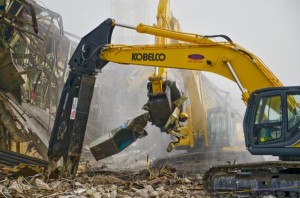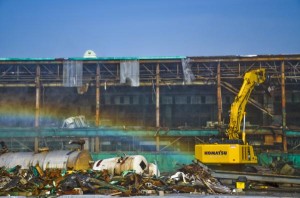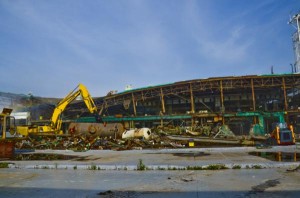PADUCAH, KY (KFVS) – The last 32 inactive facilities at the Department of Energy’s Paducah, Kentucky site are being demolished.
The C-140 Feed Plant is expected to be razed to slab by fall, ridding the site of a structure contaminated with asbestos and a low-level radioactive chemical compound called uranium hexafluoride. With an original footprint of almost 5 acres, almost equal to four football fields, the feed plant operated from 1957 to 1977 to produce uranium hexafluoride and fluorine.
“This is a significant accomplishment in our mission of safely cleaning up the site and reducing the risk to the environment and the public,” said Rob Seifert, DOE C-410 project manager.
Demolition of the feed plant began on May 13 and is about one-third finished. Large shear-equipped excavators are tearing down the feed plant from east to west. Operators are cutting steel and other debris into smaller pieces to be shipped in heavily lined, covered railcars to a commercial disposal site.
“Our main objective is to remove the building and dispose of the waste safely and efficiently,” said Butch Nolan, feed plant project manager for DOE cleanup contractor LATA Kentucky.
According to the contractor, other DOE demolition projects, such as the C-340 Metals Building razed at Paducah in 2013 and the K-33 Building razed in Oak Ridge, Tenn. in 2012, helped the feed plant team to get ahead of schedule.
To prepare the eastern area for demolition, crews removed about 800 of the facility’s 2,600 panels of exterior siding, each weighing up to 175 pounds. The siding, which contains asbestos, was manually removed and double-wrapped with protective material to guard against airborne contamination before disposal in the site’s industrial landfill. Siding removal continues on the building’s western portion.
Demolition of an eastern expansion of the feed plant, covering about half an acre, was finished ahead of schedule in late June 2011 as a result of American Recovery and Reinvestment Act funding. After the Recovery Act funding ended, workers continued to clean up the rest of the building to prepare it for demolition.
In 2012 and 2013, workers used special equipment to treat nearly 2 miles of uranium hexafluoride piping to make it safe for removal. During the pipe removal, more than a ton of residual uranium hexafluoride was treated to make it safe for handling and disposal.
Workers also removed asbestos wiring and removed and packaged 20 large pieces of equipment known as cold traps. Weighing more than 5 tons each, the cold traps were used to trap uranium hexafluoride gas and turn it into a solid. They were stored at the site for future recovery of the material during plant decommissioning when systems are in place to remove the material safely and economically.




